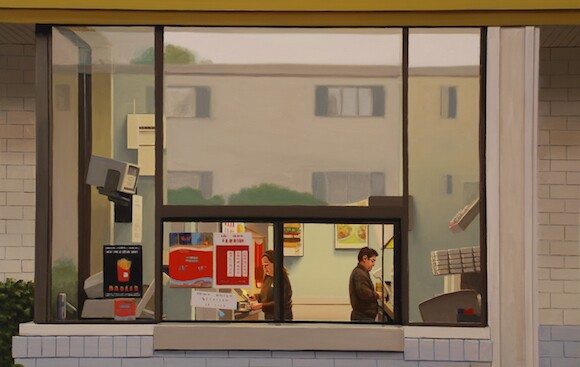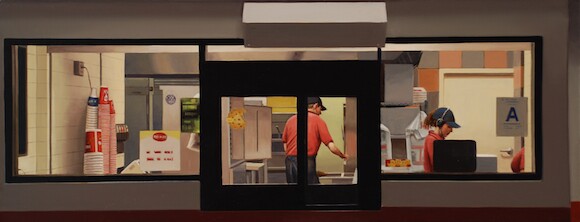Discount Stores and Drive-thrus: Marc Trujillo Paints North American Purgatory
Artbound's editorial team has reviewed and rated the most compelling weekly articles. After putting two articles up for a vote, the audience chose this article to be made into a short-format documentary.
It's not uncommon to see Marc Trujillo with a drawing tool and sketchbook in-hand when out in public. The painter, and figure drawing college professor is an active observer. In fact, often when walking down a produce aisle or waiting in line to order a meal, the artist is also playing location scout and casting manager for his next single-frame, silent film.
Recently, Trujillo was filling up at a gas station in Van Nuys when he found inspiration for producing "14114 Vanowen Street." Something about the geography of the spot caught his eye.
"I drove by it a bunch of times," he says. "I liked that the signage wasn't too over the top. I liked the empty in the middle, and the artificial colors to the natural colors."
Trujillo had to capture the establishment in oil.


Members-only wholesale clubs, discount retailers, fast-food eateries: It's the United States' commercial architecture and everyday activities associated with contemporary living that the San Fernando Valley-based artist is so interested in depicting. Through a months-long, multifaceted process, Trujillo creates detailed and vivid, visual records of "North American Purgatory" -- the spaces and places prevalent in the built environment that are not designed to be enjoyed, that most people frequent but move past through.
"It's this little slice that we spend a lot of our lives in," he says. "I like these kind of places people don't go to be there. If I paint a USA gas station, the painting has a real chance at being more of an experience than you have when you're actually there."
A native New Mexican, Trujillo has also called the states of Connecticut, New York, New Jersey, Texas and Virginia a home, yet wherever he's settled down, he's found similar subject matter to undertake.
"The Valley is great because it's a lot like a lot of the United States," he says. "It's just part of [both] the wonder and horror of the world we've made for ourselves."


And while Trujillo's scenes may appear to be photorealistic, it wouldn't be quite accurate to label them that way. His renderings of automotive service centers, home improvement specialty stores, and laundromats that dominate the country's urban landscape are not copies of singular photographs. Sometimes, even family members and friends -- including New York-based painter Hilary Harkness and Ursa, his Rottweiler -- appear as supporting characters in finished pieces.
Once Trujillo finds a site or structure to explore on canvas, he'll take several photographs and study the surrounding areas by drawing from direct observation.
"I go back and look a lot," he says.
Next, come time-intensive preparatory drawings that Trujillo creates citing various photographs and those initial illustrations he makes on-set. This step in his method is crucial as it determines the major details of his compositions -- which figures will be featured, introduced or removed, the time of day, and type of lighting.
"They're much more synthetic than they might look like at first. They really are like one-frame movies to me," he says.

Following this stage, Trujillo will scale up a finalized sketch onto a selected surface and shape an underpainting from it using raw umber or colored pencil. Once its all mapped out, everything gets covered with a matte acrylic.
Whether he's interpreting the freezer section of a grocery store or escalators in the middle of a mall, all of Trujillo's interiors contain a multitude of props and background materials. Color temperatures and forms change so frequently that when Trujillo is on his last step -- going over everything with oil -- he refers to well-organized paint notes that he's preserved from previous built artworks throughout the session.
In total, Trujillo will spend weeks interpreting, calculating and recalibrating before he dabbles with pigments. He says he's creating in traditional fashion.


There are a few things you won't see in a completed Trujillo short feature. The painter chooses not to include defining historical landmarks or elements that are tied to a specific geographical region because of the connotation they may carry.
"I won't paint palm trees in paintings because, palm trees [evoke] fantasy, a happy ending or you know, it's like vacation. It has that kind of association for me, so I'll leave it out," he says.
For this same reason, the titles of all the paintings Trujillo constructs are the street addresses of the places they depict. He says this allows him to tell viewers something that is absolutely specific and true about what he shows them, without coloring it emotionally.
"Sometimes artists will use a title like soundtrack music, to sort of falsify emotion and tell you how you're supposed to feel or think about what you're looking at, which I dislike a lot."


What Trujillo does enjoy is the challenge of portraying complex light situations (especially the sky at dusk); open and deep spaces to let observers enter and "walk around in a painting"; and big windows that let him see inside and outside at the same time.
He's even dedicated an entire series to drive-thru windows and fast food that depicts hurried human interactions and plated meals, representations that he squares off to the viewer so that they appear to be right in front of them. Trujillo admits that for this particular project, he's consuming more junk food than he maybe should be.
"I'm kind of ashamed of it, and I'm kind of into it. Just like all this stuff, if I feel all one way or the other about it, it's not interesting to me long enough to do something like sit down for months and paint it," he says. "One of the things about what I do is take this old, slow, long way of looking at things, and bringing it to bear on these things that aren't made to be looked at hardly at all."



Dig this story? Sign up for our newsletter to get unique arts & culture stories and videos from across Southern California in your inbox. Also, follow Artbound on Facebook, Twitter, and Youtube.